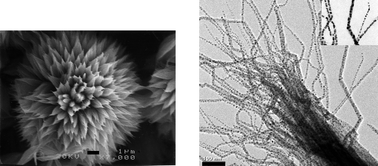Flower-like silver nanoparticle superstructures are prepared by the reaction of silver nitrate and ascorbic acid in an acidic aqueous solution of a polynaphthalene system. The three-dimensional flower-like structure has a purely hierarchic arrangement, wherein each petal is composed of bundles of silver particle chains, each enclosed in a polymer sheath. The ordering arises from strong adsorption of silver ions onto the polymer and by the interplay of the redox properties of nitric and ascorbic acid. As a result, linear silver cyanide, formed on the polymer, probably due to intrinsic electric dipole fields, organizes the silver particle chains in dumbbell-like structures, resembling buds and flower-like structures. By dilution and heating of the mother liquors, it is also possible to obtain single petals, i.e. micrometer sized bundles of linearly aggregated silver nanoparticle chains, each enclosed in a polymer sheath.
The comprehension of the hierarchic assembly of silver nanoparticles, paves the way to a facile general method to prepare polymer–metal nanoparticle chains and flower-like superstructures.
The results of this study improve both the understanding of the formation mechanism of hierarchic structures at mild temperatures and our ability to tailor them to sizes and shapes appropriate for technological purposes.


 Please wait while we load your content...
Please wait while we load your content...